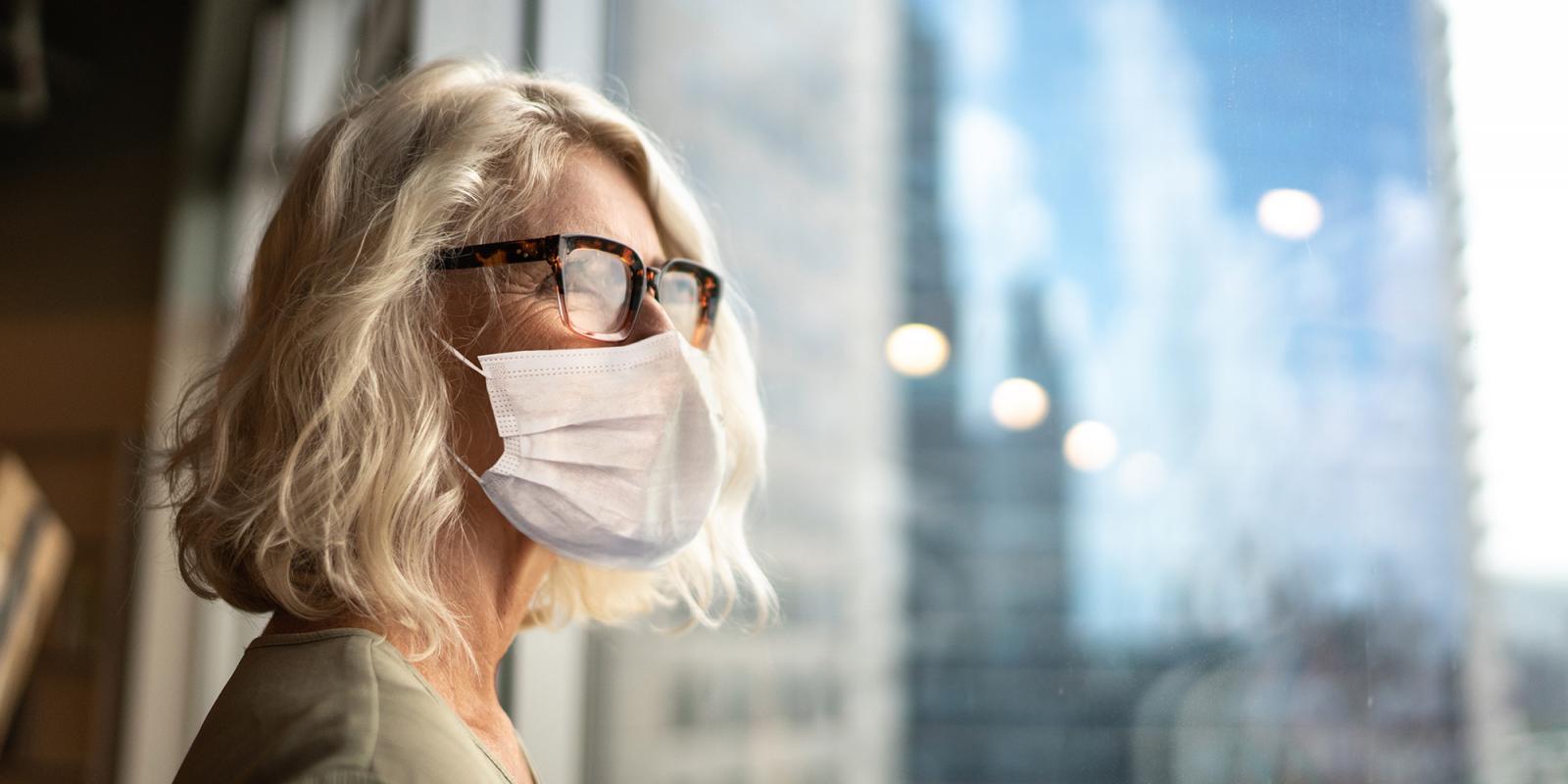From day one, COVID-19 has taken swipes at older people and the providers who serve them. But age offers perspective, and the people who choose to care for older people have proven to be more than just kind, resilient and nimble, they’ve also shown themselves to be reflective and willing to grow from this cataclysmic experience.
We’ve learned a lot about the science and spread of infection, and about preventing it. Colleen Frankenfield of Lutheran Social Ministries in New Jersey in July told us they lost 40 percent of the community’s residents and two nurses, one who died and a second who was on a ventilator and continues to have neurological issues. She described a lot of infection in March and April, but “not with the symptoms we were expecting.” We now know more and providers are less likely to be taken by surprise, although the virus is mutating.
We have seen the future and masks and eye protection will be used by clinicians for all patient encounters. Noah Marco, Chief Medical Officer of the Los Angeles Jewish Home, said when asked by staff how much longer they will have to wear masks and face shields, he told them, “Until the end of your career.”
He added that in response to the HIV/AIDS crisis, in 1985 the CDC introduced “Universal Precautions.” Before that there were no standards saying providers must wear gloves, mask, eye protection and gowns when they might get exposed to patients’ bodily fluids. In response to this pandemic, clinicians will likely be wearing PPE anytime they are in physical contact with patients.
‘People needed to know that it is OK to struggle and even their leader is struggling, too.’
We’ve learned how to quarantine those who test positive, how to care for people, including in isolation and how architecture can work to segregate cohorts (can we finally phase out shared rooms?). Soon, we’ll learn how to allocate vaccines. We can repeat lessons learned about the COVID trio—PPE, testing and staff—to be ready for the next wave.
We’ve learned that chronic underfunding and general lack of attention have left us with a patchwork long-term care system that is ripe for reform if we’re to avoid a repeat of COVID-19’s devastation. It is rewarding to see that meaningful funding to support community-based alternatives and to pay staff a living wage has become a campaign issue.
Unmasking Leadership Vulnerabilities and Skills
But many of the most profound lessons COVID-19 has delivered to providers have been about people—the workers, those they serve and those they lead. The barn having proverbially burned down, the view of the moon—the lessons of COVID—will endure.
COVID has required everyone to wear masks, but it has also unmasked those we wore that obscured leadership, confidence and strength. Authentic aging services leaders no longer project that they always have the answer, are not afraid or will stick with every decision they make even if it’s not working out.
Recently I participated in a session with provider leaders on COVID-19 lessons, addressing “what did COVID reveal to you about yourself as a leader?” The lessons these leaders shared echo many we’ve heard from providers across the country in recent months and apply well beyond aging services, to all leaders.
Trust and communication always rise to the top. I’ve spoken with hundreds of providers at all levels and in all types of aging services communities. When asked about their most powerful lesson, more often than not, it comes down to trust and communication. You have to tell people the unvarnished truth. Hiding information when someone tests positive—or gets sick or dies—will backfire. Leaders talk about sharing news through daily meetings, in regular notes to staff and by walking around.
One administrator told us she called every resident’s family every day. “My team members trust me to be honest with them, and that creates loyalty. If I tell them it’s safe to work in the COVID unit, they know they needn’t fear.”
Listening. Coupled with transparency and trust is focused listening. Everyone has challenges and difficulties in COVID time. When leaders take the time to find out what’s behind team members’ reactions, they can make changes based on those circumstances. And it makes the whole team stronger.
“Forgive people for being someone other than who you are,” said Carol Silver Elliott of the Jewish Home Family in Rockleigh, NJ.
Continually offer grief supports. Loss and grief come with the territory for those working in aging services. But COVID has been an exceptional catalyst for a massive increase in illness and death. Staff lose beloved people they care for.
They also lose precious coworkers. One provider told us how one nurse aide’s death rocked the entire team. In addition to the loss of the person, it is a stark realization that coming to work and doing your job could take your life.
Be authentic, even if it leaves you exposed and vulnerable. Julie Thorson of Friendship Haven in Fort Dodge, Iowa, said that to lead humans, you must be human. She describes how fatigue is setting in across the staff. She planned a community wide meeting during which she would deliver an inspirational message.
“Instead I started talking and burst out in tears.” She said she felt “raw and vulnerable,” but the episode was more important for the team than she had realized. “People needed to know that it is OK to struggle and even their leader is struggling, too.”
But be tenacious. And notice and appreciate every victory. Elliott’s Jewish Home Family is a stone’s throw from New York City. She describes being hit really hard in that early hotspot, and being advised by medical experts to prepare to provide palliative and end-of-life care, given the frailties of the older people she serves.
She said, “Not on my watch. We are going to fight with everything we have.” She determined that everyone was essential. She and her team jumped on testing, hydration, repositioning people, doing whatever it takes. Given the extent of COVID in the surrounding community, there were some losses. But the Jewish Home Family pulled out all the stops and celebrated every resident that recovered.
Accept uncertainty. We spoke with Phil Jacob from Texas, a nursing home administrator who tested positive and had “a bad three weeks,” but then remained positive and had to quarantine for more than eight. This was before the CDC issued revised guidance about returning to work 10 (or 20 in some cases) days after symptoms disappear. The corollary to living with uncertainty is “never let down your guard.”
Be ready to reinvent how you approach the work and use resources. “We spent years building up our incredible resources, then COVID came and wiped it all out,” one provider said. “So we had to reinvent.”
Deborah Royster of Seabury Resources for Aging, used her community-based organization’s resources—like transportation and relationships with older adults in the community—to dramatically increase meal delivery to elders newly isolated at home.
Don’t lose sight of why you went into aging services. As one provider in the leadership session said, “I’ve dedicated my life to taking care of seniors. It’s not about me, it’s about them.” Dedication and commitment inspire confidence.
Build team cohesion through adversity. Team bonding, uniting against a common enemy, is at an all-time high in well-led organizations. Leaders who used COVID-19 to strengthen their commitment to a strong, collaborative, team culture are reaping the benefits in less burnout and turnover. Providers talk about everyone learning to do many jobs—from serving meal trays to helping people in isolation stay connected with their loved ones using technology. Shared grief has brought many teams closer, too.
Fun, self-care, re-creation. The COVID pandemic has demanded more of aging services providers than anything that has come before. It is neither fun nor funny, but staying in touch with one’s own humanity has been essential to many. As one provider said, “our team tries to find fun where we can.” One person laughingly responded to the leadership question (What did COVID reveal to you?): “COVID revealed my natural hair color, which I hadn’t seen in a long time!”
Self-care comes up in any discussion of leadership lessons. Across the board, provider community leaders describe not taking a day off since the beginning. Many moved onto their campuses.
“But we have to get over ourselves,” a provider in the leadership session said. Everyone needs to take time to refresh and renew connections with family and others outside of work. As Thorson says, “when staff come back, they return with an open heart and a readiness to listen.”
A lot of work remains, but we are stronger. Despite emergency planning requirements for aging services providers, COVID has been an example of how people can plan, but the universe laughs. We have a lot of work ahead of us in building and financing a robust aging services system that offers meaningful choice to an aging population.
But let’s not take for granted or lose sight of the hard work aging services leaders have been doing and their extraordinary self-reflection. This exponential growth provides a solid foundation for the future system that—we hope—awaits us all.
Author note: Thanks to Lisa Henderson, CEO of LeadingAge Maine/New Hampshire, for convening the leadership session from the article, and to Carol Silver Elliott and Julie Thorson for helping to frame and lead the discussion.
Ruth Katz is the senior vice president of public policy at LeadingAge in New York City, and a member of the Generations Editorial Advisory Board.













